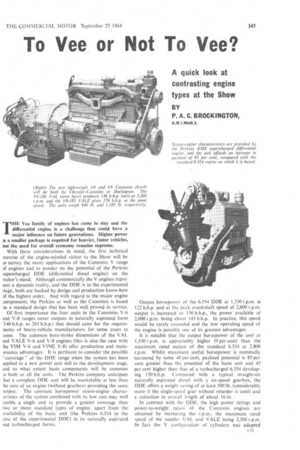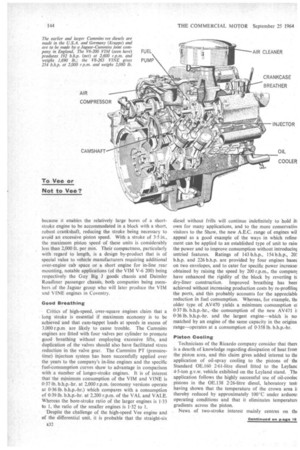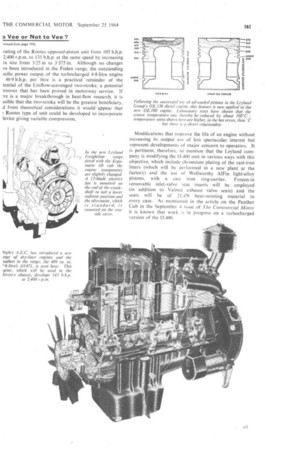To Vee or Not To Vee?
Page 147

Page 148

Page 165

If you've noticed an error in this article please click here to report it so we can fix it.
A quick look at contrasting engine types at the Show
BY P. A. C. BROCKINGTON,
THE Vee family of engines has come to stay and the differential engine is a challenge that could have a major influence on future generations. Higher power in a smaller package is required for heavier, faster vehicles, hut the need for overall economy remains supreme.
With these considerations in mind, the first technical :xercise of the engine-minded visitor to the Show will be 0 survey the many applications of the Cummins V range A engines and to ponder on the potential of the Perkins nwercharged DDE (differential diesel engine) on the naker's stand. Although commercially the V engines repremnt a dynamic reality, and the DDE is in the experimental itage, both are backed by design and production know-how A the highest order. And with regard to the major engine omponents, the Perkins as well as the Cummins is based 3n a standard design that has been well proved in service.
Of first importance the four units in the Cummins V-6 tnd V-8 ranges cover outputs in naturally aspirated form 140 b.h.p. to 265 b.h.p.) that should cater for the requirements of heavy-vehicle manufacturers for some years to :ome. The common bore-stroke dimensions of the VAL Ind VALE V-6 and V-8 engines (this is also the case with he VIM V-6 and VINE V-8) offer production and main:enance advantages. It is pertinent to consider the possible ' coverage " of the DDE range when the system has been ipplied to a new power unit still in the deVelopment stage, ind to what extent basic components will be common -0 both or all the units. The Perkins company anticipate hat a complete DDE unit will be marketable at less than he cost of an engine (without gearbox) providing the same )utput. The constant horsepower steam-engine characeristics of the system combined with its low cost may well mable a single unit to provide a greater coverage than two or more standard types of engine, apart from the tvailability of the basic unit (the Perkins 6.354 in the :ase of the experimental DDE) in its naturally aspirated ind turbocharged forms.
Output horsepower of the 6.354 DDE at 1,350 r.p.m. is 122 b.h.p. and at the peak crankshaft speed of 2,800 r.p.m. output is increased to 156 b.h.p., the power available at 2,000 r.p.m. being about 143 b.h.p. In practice, this speed would be rarely exceeded and the low operating speed of the engine is possibly one of its greatest advantages.
It is notable that the output horsepower of the unit at 1,350 r.p.m. is appreciably higher (9 per cent) than the maximum rated output of the standard 6.354 at 2.800 r.p.m. Whilst maximum useful horsepower is nominally increased by some 40 per cent, payload potential is 85 per cent greater than the potential of the basic unit and 45 per cent higher than that of a turbocharged 6.354 develop ing 150 b.h.p. Compared with a typical straight-six naturally aspirated diesel with a six-speed gearbox, the DDE offers a weight saving of at least 500 lb. (considerably more it the single-speed gear without retarder is used) and a reduction in overall length of about 16 in.
In contrast with the DDE. the high power ratings and power-to-weight ratios of the Cummins engines are obtained by increasing the r.p.m., the maximum rated speed of the smaller VAL and VALE being 3,300 r.p.m. In fact the V configuration of cylinders was adopted because it enables the relatively large bores of a shortstroke engine to be accommodated in a block with a short, robust crankshaft, reducing the stroke being necessary to avoid an excessive piston speed. With a stroke of 3.5 in., the maximum piston speed of these units is considerably less than 2,000 ft. per min. Their compactness, particularly with regard to length, is a design by-product that is of special value to vehicle manufacturers requiring additional over-engine cab space or a short engine for in-line rear mounting, notable applications (of the VIM V-6 200) being respectively the Guy Big J goods chassis and Daimler Roadlmer passenger chassis, both companies being members of the Jaguar group who will later produce the VIM and VINE engines in Coventry.
Good Breathing • Critics of high-speed, over-square engines claim that a long stroke is essential if maximum economy is to be achieved and that cam-tappet loads at speeds in excess of 3,000 r.p.m are likely to cause trouble. The Cummins engines are fitted with four valves per cylinder to promote good breathing without employing excessive lifts, and duplication of the valves should also have facilitated stress reduction in the valve gear. The Cummins PT (pressuretime) injection system has been successfully applied over the years to the company's in-line engines and the specific fuel-consumption curves show to advantage in comparison with a number of longer-stroke engines. It is of interest that the minimum consumption of the VIM and VINE is 0.37 lb. b.h.p.-hr. at 2,000 r.p.m. (economy versions operate at 0-36 lb. b.h.p.-hr.) which compares with a consumption of 0.39 lb. b.h.p.-hr. at 2,200 r.p.m. of the VAL and VALE. Whereas the bore-stroke ratio of the larger engines is 1.33 to I, the ratio of the smaller engines is 1-32 to I.
Despite the challenge of the high-speed Vee engine and of the differential unit, it is probable that the straight-six diesel without frills will continue indefinitely to hold it own for many applications, and to the more conservative visitors to the Show, the new A.E.C. range of engines wit appeal as a good example of the ways in which refine. merit can be applied to an established type of unit to raise the power and to improve consumption without introducing untried features. Ratings of 143 b.h.p., 154 b.h.p., 20.! b.h.p. and 226 b.h.p. are provided by four engines base( on two envelopes, and to cater for specific power increase: obtained by raising the speed by 200 r.p.m., the compan3 have enhanced the rigidity of the block by reverting tc dry-liner construction. Improved breathing has beer achieved without increasing production costs by re-profiling the ports, arid this probably accounts for the appreciable reduction in fuel consumption. Whereas, for example, the older type of AV470 yields a minimum consumption 01 0.37 lb. b.h.p.-hr., -the consumption of the new AV47I 0-36 lb. b.h.p.-hr. and the largest engine—which is no matched by an engine of the same capacity in the origina range—operates at a consumption of 0-358 lb. b.h.p.-hr.
Piston Cooling Technicians of the Ricardo company consider that there is a dearth of knowledge regarding dissipation of heat froff the piston area, and this claim gives added interest to the application of oil-spray cooling to the pistons of the Standard 0E.160 261-litre diesel fitted to the Leylanc 4.5-ton g.v.w. vehicle exhibited on the Leyland stand. .The application follows the highly successful use of oil-coolex pistons in the 0E.138 2.26-litre diesel, laboratory testi having shown that the temperature of the crown area thereby reduced by approximately 100°C under arduow operating conditions and that it eliminates temperature gradients across the piston.
News of two-stroke interest mainly centres on thE rating of the Rootes opposed-piston unit from 105 b.h.p. 2,400 r.p.m. to 135 b.h.p. at the same speed by increasing re size from 3.25 in to 3-375 in. Although no changes ye been introduced in the Foden range, the outstanding !cific power output.of the turbocharged 4.8-litre engine 46.9 b.h.p. per litre is a practical reminder of the tential of the Uniflow-scavenged two-stroke, a potential )reover that has been proved in motorway service. If !re is a major breakthrough in heat-flow research, it is ssible that the two-stroke will be the greatest beneficiary, d from theoretical considerations it would appear that Rootes type of unit could be developed to incorporate levice giving variable compression. Modifications that improve the life of an engine without increasing its output are of less spectacular interest but represent developments of major concern to operators. It is pertinent, therefore, to mention that the Leyland company is modifying the 0.400 unit in various ways with this objective, which include chromium plating of the cast-iron liners (which will be performed in a new plant at the factory) and the use of Wellworthy AlFin light-alloy pistons, with a cast iron ring-carrier. Frozen-in removable inlet-valve seat inserts will be employed (in addition to Valmet exhaust valve seats) and the seats will be of 21.4N heat-resisting material in every case. As mentioned in the article on the Panther Cub in the September 4 issue of The Comnrercial Motor it is known that work is in progress on a turbocharged version of the 0.400.






































































































































































































































































































































































































